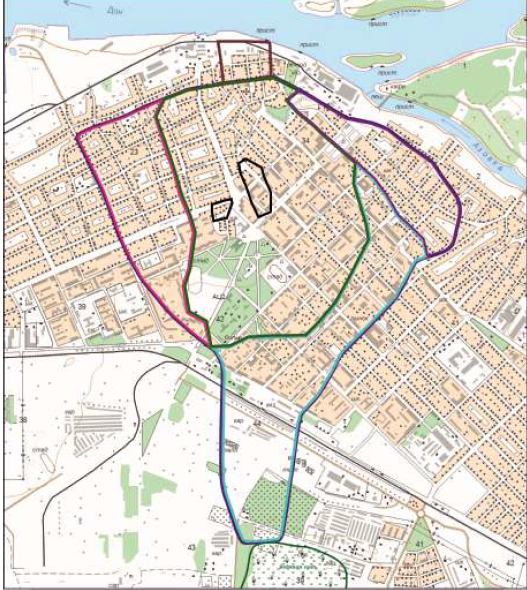ABOUT DEMOGRAPHICS OF THE GOLDEN HORDE AZAK AND ITS DISTRICT
DOI:
https://doi.org/10.24852/2587-6112.2024.2.241.252Keywords:
archaeology, Golden Horde, Azak, nomads, demographics, urban density, reconstruction of the populationAbstract
The paper presents calculation of the population of the Golden Horde Azak and its district based on the analysis of the results of long-term excavations of the Golden Horde Azak. The most reliable data are available for the period around 1340, when the population of the city was 54 thousand inhabitants. To determine the dynamics of the city's development, calculations are also given for the periods around 1290 and 1395, when the city's population was about 3.0-3.5 and 12.5-13.5 thousand inhabitants. The number of nomads in territories economically gravitating towards Azak can be estimated at 250 thousand people, this number is rather an upper limit. The question of the size of the non-nomadic population of the Azak district remains unclear, since even the approximate number of sedentary settlements is unknown, therefore the estimate of more than 300 thousand inhabitants proposed in the article is speculative. Despite the approximate calculations, such studies are necessary for a proper understanding of the history of the Golden Horde. The data presented in this paper will be updated, but the order of the numbers will most likely not change. Based on data on the population of Azak, we can conclude that during its heyday it was one of the largest cities not only in Eastern Europe, but in Europe as a whole. Based on the data on the size of the city, it allows us to conclude that it acted not only as a center of intermediary transcontinental trade, but also as a trade and craft center of a large region. Research similar to that presented in this article should be carried out in the future for other regions of the Golden Horde.
References
Akhiezer, G., Kramarovsky, M. G. 2023. In Zolotoordynskoe obozrenie (Golden Horde Review) 11 (1), 79–108 (in Russian).
Bol'shakov, O. G. 2001. Srednevekovyi gorod Blizhnego Vostoka. VII – seredina XIII v. Sotsial'noekonomicheskie otnosheniya (Medieval Town of the Middle East. 7th - mid-13th centuries. Socio-economic relations). Moscow: “Vostochnaia Literatura” Publ. (in Russian).
Kravchenko, E. E. 2015. In Bocharov, S. G., Sitdikov, A. G. (eds.). Genuezskaia Gazariia i Zolotaia Orda (The Genoese Gazaria and the Golden Horde). Kazan; Simferopol; Kishinev: “Stratum Plus” Publ., 411–478 (in Russian).
Kramarovsky, M. G. 2009. In Usmanov, M. A. (ed.). Istoriia tatar s drevneishikh vremen v semi tomakh. Tom III: Ulus Dzhuchi (Zolotaia Orda). XIII –seredina XV (History of the Tatars since Ancient Times in seven volumes. Volume 3: The Ulus of Jochi (the Golden Horde). 13th – mid. 15th cc.). Kazan: Institute of History named after Shigabuddin Mardzhani, Tatarstan Academy of Sciences, 567–589 (in Russian).
Kuchkin, V. A. 2013. In Shveikovskaya, E. N. (ed.). Obrazy agrarnoy Rossii IX–XVIII vv. (Images of agrarian Russia of the IX–XVIII centuries).Moscow: “Indrik” Publ., 67–88 (in Russian).
Livi Bachchi. 2010. Demografi cheskaya istoriya Evropy (Demographic history of Europe). Saint Petersburg: “Aleksandriia” Publ. (in Russian).
Makarov, N. A. 2017. In Rossiiskaia Arkheologiia (Russian Archaeology) (2), 57–69 (in Russian).
Maslovsky, A. N. 2014. In Sitdikov A. G., Makarov N. A., Derevianko A. P. (eds.). Trudy IV (XX) Vserossiiskogo arkheologicheskogo s″ezda v Kazani (Proceedings of the 4th (20th) All-Russia Archaeological Congress in Kazan) III. Kazan: “Otechestvo” Publ., 401–403 (in Russian).
Maslovsky, A. N. 2019. In Bocharov, S. G., Sitdikov A. G. (eds.). Genuezskaia Gazariia i Zolotaya Orda (The Genoese Gazaria and the Golden Horde). 2. Kazan; Kishinev: Institute of Archaeology named after A. Kh. Khalikov, Tatarstan Academy of Sciences, 641–656 (in Russian).
Nedashkovskii, L. F. 2000. Zolotoordynskiy gorod Ukek i ego okruga (The Golden Horde City Ukek and its Suburbs). Moscow: “Vostochnaia Literatura” Publ. (in Russian).
Romanchuk, A. I. 2000. Ocherki istorii i arkheologii vizantiyskogo Khersona (Essays on the history and archaeology of Byzantine Kherson). Ekaterinburg: Ural State University (in Russian).
Tortika, A. A. 2016. In Zinko, V. N. (ed.). Bosporskie issledovaniia (Bosporan Studies) XXXIII. Kerch: “Kerchenskaya gorodskaya tipografi ya” Publ., 210–240 (in Russian).
Tortika, A. A., Mikheev, V. K. 2001. In Pryakhin, A. D. (ed.). Arkheologiia Vostochnoevropeiskoi lesostepi (Archaeology of the East-European Forest-Steppe Zone) 15. Voronezh: Voronezh State University, 141–161 (in Russian).
Urlanis, B. Ts. 1941. Rost narodonaseleniya v Evrope (Opyt ischisleniya) (Growth of population in Europe (Calculation experience)).Moscow: “OGIZ- Gospolitizdat ” Publ.” (in Russian).

Downloads
Published
How to Cite
Issue
Section
License
Copyright (c) 2024 Maslovsky Andrey N., Papka Inessa Bovna

This work is licensed under a Creative Commons Attribution-NonCommercial 4.0 International License.







